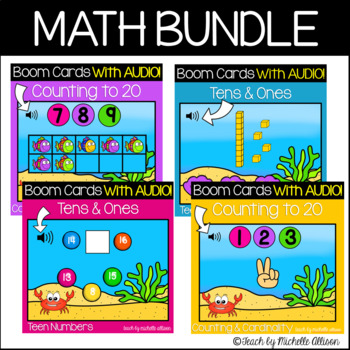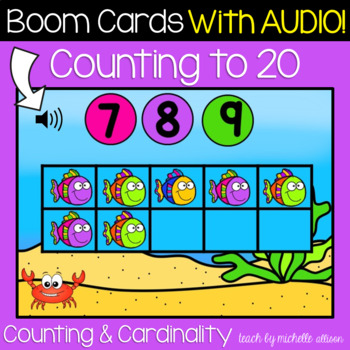Kindergarten Counting Games | Math Boom Cards WITH AUDIO
- Zip
- Internet Activities
Products in this Bundle (4)
Description
You'll love this no-prep bundle of kindergarten math Boom Cards with audio! This bundle of Boom Cards™ reviews kindergarten math skills including number sense, counting, place value, and missing numbers. Teachers will love these no-prep math games, and students will love this engaging way to review math skills.
Use this deck to model a lesson during whole group instruction, reinforce skills in small groups, as independent word work centers, as a formative assessment, or as part of your data collection for RTI intervention!
WHAT'S INCLUDED?
This resource includes a PDF document with a link to download the Boom Cards hosted on BOOM Learning:
⭐Counting and Cardinality | Counting to 20 with Ten Frames | BOOM Cards
⭐Building Number Sense | Subitizing | BOOM Cards
⭐Building Number Sense | Ordering Numbers | BOOM Cards
⭐Place Value | Tens and Ones | BOOM Cards
TEACHERS LIKE YOU SAID…
⭐️⭐️⭐️⭐️⭐️ Lynn said, " Boom Cards are great extra practice for my students! It is so helpful to have the audio for my English Language Learners."
⭐️⭐️⭐️⭐️⭐️ Kyle said, " I love using Boom Cards with the whole group, small group, and to assign to individual students. My students are learning and applying what they know with immediate feedback."
Terms
Copyright © Michelle Staley. All rights reserved by the author. This product is to be used by the original downloader only. Copying for more than one teacher, classroom, department, school, or school system is prohibited. This product may not be distributed or displayed digitally for public view. Failure to comply is a copyright infringement and a violation of the Digital Millennium Copyright Act (DMCA). Clipart and elements found in this PDF are copyrighted and cannot be extracted and used outside of this file without permission or license. Intended for classroom and personal use ONLY. See product file for clip-art and font credits.
Important Information from BOOM Learning
Using Boom Cards: To use Boom Cards, you must be connected to the Internet. Boom Cards play on modern browsers (Chrome, Safari, Firefox, and Edge). Apps are available for Android, iPads, iPhones, and Kindle Fires. For security and privacy, adults must have a Boom Learning account to use and assign Boom Cards. You will be able to assign the Boom Cards you are buying with "Fast Pins," (play provides instant feedback for self-grading Boom Cards). Fast Play is always a free way for students to engage with Boom Cards decks. For additional assignment options, you'll need a premium account. If you are new to Boom Learning, you will be offered a free trial of our premium account. Read here for details: http://bit.ly/BoomTrial.
Common Core State Standard Correlations:
Know number names and the count sequence.
CCSS.MATH.CONTENT.K.CC.A.1
Count to 100 by ones and by tens.
CCSS.MATH.CONTENT.K.CC.A.2
Count forward beginning from a given number within the known sequence (instead of having to begin at 1).
Count to tell the number of objects.
CCSS.MATH.CONTENT.K.CC.B.4
Understand the relationship between numbers and quantities; connect counting to cardinality.
CCSS.MATH.CONTENT.K.CC.B.4.A
When counting objects, say the number names in the standard order, pairing each object with one and only one number name and each number name with one and only one object.
CCSS.MATH.CONTENT.K.CC.B.4.B
Understand that the last number name said tells the number of objects counted. The number of objects is the same regardless of their arrangement or the order in which they were counted.
CCSS.MATH.CONTENT.K.CC.B.4.C
Understand that each successive number name refers to a quantity that is one larger.
CCSS.MATH.CONTENT.K.CC.B.5
Count to answer "how many?" questions about as many as 20 things arranged in a line, a rectangular array, or a circle, or as many as 10 things in a scattered configuration; given a number from 1-20, count out that many objects.
Work with numbers 11-19 to gain foundations for place value.
CCSS.MATH.CONTENT.K.NBT.A.1
Compose and decompose numbers from 11 to 19 into ten ones and some further ones, e.g., by using objects or drawings, and record each composition or decomposition by a drawing or equation (such as 18 = 10 + 8); understand that these numbers are composed of ten ones and one, two, three, four, five, six, seven, eight, or nine ones.





